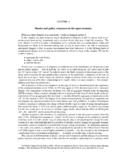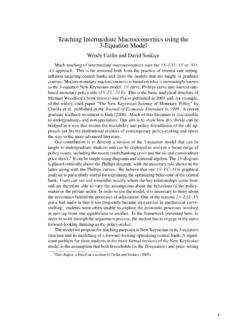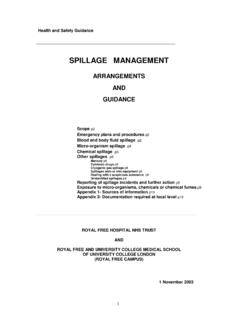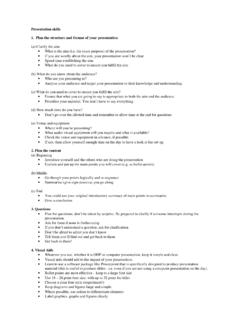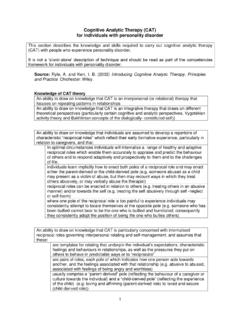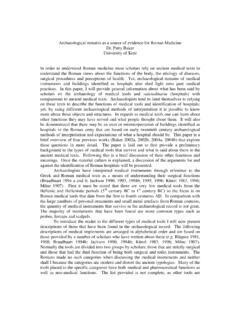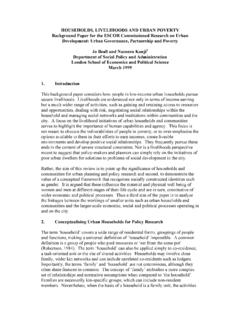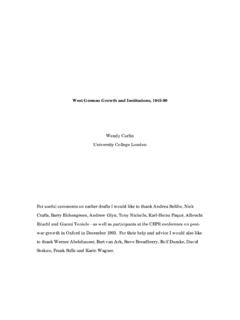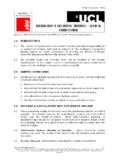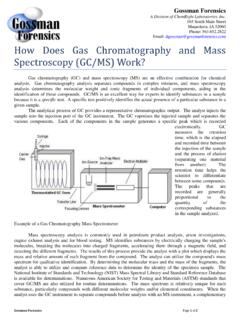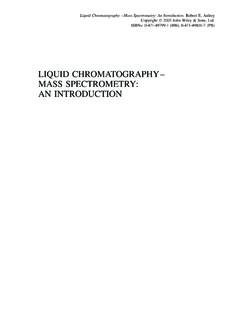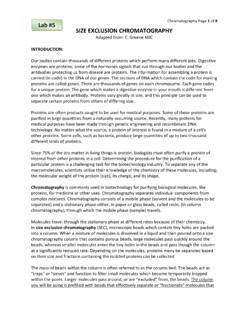Transcription of An Introduction to Gas Chromatography Mass Spectrometry
1 An Introduction to Gas Chromatography mass Spectrometry Dr Kersti Karu email: Office number: Room LG11 Recommended Textbooks:- Analytical Chemistry , G. D. Christian, P. K. Dasgupta, Schug, Wiley, 7th Edition Trace Quantitative Analysis by mass Spectrometry , Boyd, , Bethem, Wiley mass Spectrometry Principles and Applications , E. de Hoffmann, V. Stroobant, Wiley GC applications Forensic Environmental Food, flavour Drug development Energy and fuel Lecture Overview Overview of mass Spectrometry instruments mass Spectrometer definition Gas Chromatography mass Spectrometry instrument overview Fundamentals of Chromatographic Separation Principles of chromatographic separations Classification of chromatographic techniques Adsorption Chromatography Partition Chromatography Gas Chromatography (GC)
2 Theory of column efficiency in Chromatography Rate theory of Chromatography - the Van Deemter equation GC mobile phase Retention factor efficiency and resolution Resolution in Chromatography Gas Chromatography columns Gas Chromatography mass Spectrometry (GC-MS) Ionisation methods Electron Impact Ionisation (EI) /Chemical Ionisation (CI) Quadrupole (Q) mass analyser Block diagram of a mass spectrometer Ssample inlet ion source analyser detector GC LC CE gas probe EI CI APCI APPI ESI MALDI DESI DART Quadrupole ion trap TOF magnetic orbitrap ICR electron multiplier: discrete dynode continuous dynode MCP Multiple forms exist for each instrument component, and they can usually be mixed and matched.
3 Analysers can be used in single, , Q or TOF, or in multi-analyser formats, , QTOF and TOF/TOF, with a collision cell incorporated between the two analysers. The computer controls the instrument, acquires data and enables routine data processing, producing and quantifying spectra. A mass spectrometer is an analytical instrument that produces a beam of gas ions from samples (analytes), sorts the resulting mixture of ions according to their mass -to-charge (m/z) ratios using electrical or magnetic fields, and provides analog or digital output signal (peaks) from which the mass -to charge ratio and the intensity (abundance) of each detected ionic species may be determined.
4 End of column entrance of ion source m/z Samples are introduced into the GC using a heated injector. Components are separated on a column, according to a combination of molecular mass and polarity, and sequentially enter the MS source via a heated transfer region. The analytical data consists of total ion chromatograms (TIC) and the mass spectra of the separated components. GC MS Heated injector injector GC column analyzer ion source heated transfer region TIC output m / z time Gas Chromatography - mass spectrometer (GC-MS) Key equations for Chromatography Plate height H = Plate number N = t w Adjustment retention time t R = tR tM Retention factor k = Van Deemter Equation H = A + + Capillary (open tubular)
5 GC Column Golay equation H = A + + + Cm Packed GC column Resolution = 2 1 1+ 22 Separation factor = 2 1 = 2 1 Resolution Rs = 14 ( 1 ) ( 2 +1) In 1901 Mikhail Tswett invented adsorption Chromatography during his research on plant pigment. He separated different coloured chlorophyll and carotenoid pigments of leaves by passing an extract of the leaves through a column of calcium carbonate, alumina and sucrose eluting them with petroleum ether/ethanol mixtures.
6 He coined the term Chromatography in a 1906 publication, from the Greek words chroma meaning colour and graphos meaning to write . The international Union of Pure and Applied Chemistry (IUPAC) has drafted a recommended definition of Chromatography :- Chromatography is a physical method of separation in which the components to be separated are distributed between two phases, one of which is stationary (stationary phase), while the other (the mobile phase) moves in a definite direction . [ Ettre, Nomenclature for Chromatography , Pure & Appl.]
7 Chem., 65 (1993), 819-872]. The two principal types of Chromatography are gas Chromatography (GC) and liquid Chromatography (LC). Gas Chromatography separates gaseous substances based on partitioning in a stationary phase from a gas phase. Liquid Chromatography includes techniques such as size exclusion (separation based on molecular size), ion exchange (separation based on charge) and high-performance liquid Chromatography (HPLC separation based on partitioning from a liquid phase) Principles of chromatographic separations While the mechanisms of retention for various types of Chromatography differ, they are all based on the dynamic distribution of an analyte between a fixed stationary phase and a flowing mobile phase.
8 Each analyte will have a certain affinity for each phase. K= where cs and cm are the stationary and the mobile phases concentrations. The distribution of the analyte between two phases is governed by:- temperature, the physico-chemical properties of compound, the stationary and mobile phases. Analytes with a large K value will be retained more strongly by the stationary phase than those with a small K value. The result is that the latter will move along the column (be ELUTED) more rapidly. Classification of chromatographic techniques Chromatographic processes can be classified according to the type of equilibration process involved, which is governed by the type of the stationary phase.
9 Various bases of equilibration are:- exchange dependent pore penetration Chromatography More often that not, analyte stationary-phase-mobile-phase interactions are governed by a combination of such processes. Adsorption Chromatography The stationary phase is a solid on which the sample components are adsorbed. The mobile phase may be a liquid (liquid-solid Chromatography ) or gas (gas-solid Chromatography ); the components distribute between two phases through a combination of sorption and desorption processes. Thin-layer Chromatography (TLC) the stationary phase is planar, in the form of a solid supported on an inert plate, and the mobile phase is a liquid.
10 Partition Chromatography The stationary phase is usually a liquid supported on a solid or a network of molecules, which functions as a liquid, bonded on the solid support. The mobile phase may be a liquid (liquid-liquid partition Chromatography ) or a gas (gas-liquid Chromatography , GLC). Normal phase Chromatography has a polar stationary phase ( cyano groups bonded on silica gel) and the mobile phase is non-polar ( hexane). When analytes dissolved in the mobile phase are introduced into the system, retention increases with increasing polarity.
